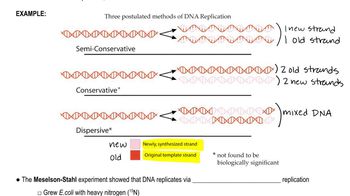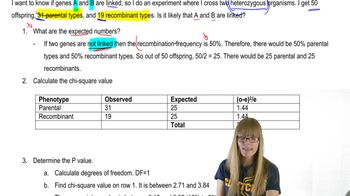Here are the essential concepts you must grasp in order to answer the question correctly.
DNA Replication Models
DNA replication can occur through different models: conservative, semi-conservative, and dispersive. In the conservative model, the original DNA molecule remains intact, and an entirely new copy is made. In the dispersive model, the original DNA is broken into pieces, and new DNA is interspersed with the old, resulting in hybrid molecules. Understanding these models is crucial for predicting experimental outcomes.
Recommended video:
Semi-Conservative Replication
The semi-conservative model of DNA replication, proposed by Watson and Crick, suggests that each new DNA molecule consists of one original strand and one newly synthesized strand. This model was confirmed by the Meselson-Stahl experiment, which demonstrated that DNA replication conserves half of the parental DNA in each daughter molecule. This concept is essential for understanding how genetic information is accurately passed on during cell division.
Recommended video:
Semiconservative Replication
Experimental Predictions
In the context of the Taylor, Woods, and Hughes experiment, predictions about the outcomes of conservative and dispersive replication can be made based on the structure of the resulting DNA. For conservative replication, one would expect to see distinct bands of original and new DNA, while dispersive replication would yield a more uniform distribution of DNA density. These predictions help in interpreting experimental results and understanding the nature of DNA replication.
Recommended video:






